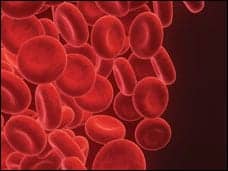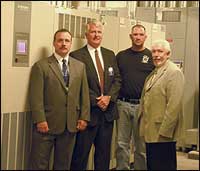A new kind of MRS imaging may provide great potential for prostate cancer diagnosis and treatment.

|
Magnetic resonance spectroscopy (MRS) with cellular metabolites has been utilized to some degree since the 1970s, but its success has been limited because of lack of sensitivity. While it is possible to get some spatial information about metabolism and the biochemical changes using current MRS techniques, the results have been less than optimal for widespread clinical usage such as diagnosing cancers or other disease states.
Recently, however, GE Healthcare, Waukesha, Wis, has invested in a device that can greatly enhance MRS sensitivity using hyperpolarized carbon 13 (13C) labeled metabolic substrates. When injected in vivo and scanned with a specially configured MR, these unique hyperpolarized labeled substrates have shown the potential not only to reveal small amounts of cancers, but also to quickly assess the metabolic changes in tumors shortly after a therapy. There are many other potential clinical applications for this new technology, but GE Healthcare researchers will first be focusing on assessing prostate cancer for FDA approval.
All in the DNP
The key innovation with this new MRS technique is GE’s new dynamic nuclear polarizer (DNP) technology, which can effectively hyperpolarize 13C labeled metabolic substrates, such as pyruvate, lactate, and bicarbonate. In laboratory experiments, these hyperpolarized substrates have been injected into preclinical models of prostate and other cancers and then scanned with an MR. The 13C labeled metabolic substrates dramatically improved the resulting image’s signal-to-noise ratio, revealing both anatomic and metabolic information in the tumors.
GE is so enthusiastic about the potential of utilizing its DNP with MRS for prostate cancer and other clinical applications that it has structured a collaborative team of researchers from 14 different global institutions, who share their findings on a regular basis and exchange research fellows as well as their latest techniques.
Pyruvate and Potential Applications
Global researchers are experimenting with a number of different 13C substrates for different clinical applications. Pyruvate, lactate, and bicarbonate have all been effectively hyperpolarized, and researchers are now in the process of discovering their effectiveness in diagnosis, as well as their safety in humans.
A team at University of California San Francisco, led by John Kurhanewicz, PhD, professor of radiology, urology, and pharmaceutical chemistry, selected pyruvate for its experiments in prostate cancer applications.
“Prostate cancer is a really difficult cancer to deal with because it can be indolent, which is a good thing for the patients,” Kurhanewicz explained. “There’s a lot of the disease that we detect in men that probably won’t evolve into clinically significant disease, but because we’re detecting it earlier and at a smaller stage in younger men, we tend to treat it because it is cancer. So, there’s this big dilemma about whether to treat the disease, and once you decide that, you need to treat it aggressively.”
MRS with pyruvate could not only potentially diagnose small amounts of cancer, but also could help physicians quickly evaluate the therapy chosen. Typically, cancer therapy response is determined by waiting weeks to see whether a tumor has shrunk in size. Using the hyperpolarized 13C pyruvate MRS technique has demonstrated therapy information the same day in mice and could allow oncologists to swiftly choose a different therapy.

|
| The GE Signa HD750 3.0T is an MR scanner with multi-nuclear capabilities and offers the strongest gradient performance for the new diagnostic technique. |
“Pyruvate is at a very unique metabolic crossroads,” Kurhanewicz said, “because it can be transformed into Alanine/bialanine transanimates that go into protein and amino acid synthesis, which is important to cancer. Pyruvate can also be converted into lactic acid, and we know that tumors produce a lot of lactate, which is pumped out of the cell to the extracellular spaces. It makes the microenvironment around the tumor acidic, which has a lot of implications for the progression of this disease.”
Kurhanewicz’s hope is that radiologists will one day be able to watch the uptake of the hyperpolarized pyruvate by the cancer tissue and see, in real time, the pyruvate being metabolized into various different pathways. That potentially could not only give clinicians an idea of the presence of the cancer, but also could help them to characterize the aggressiveness of the disease and assess the effectiveness of therapies.
Other Potential Applications
Another researcher collaborating within the DNP team is Kevin Brindle, PhD, professor of biomedical magnetic resonance at the University of Cambridge, Cambridge, UK, who has recently co-authored a paper on hyperpolarizing bicarbonate for oncology imaging applications. Instead of pyruvate, Brindle’s team at Cambridge chose bicarbonate for in vivo pH images.
“Almost all disease is associated with a low tissue pH,” Brindle said. “So infection, inflammation, cancer tumors, ischemia, hypoxia, are all characterized by a lower tissue pH. If you have a method that allows you to image tissue pH, then you’d have a generic method for detecting disease. That’s what we’ve shown, that you can image pH in vivo. There are methods that you can use in the laboratory to do this, but nothing you can use in the clinic.”
Brindle’s team took 13C-labeled bicarbonate and injected it intravenously into mice. Since bicarbonate is converted into carbon dioxide in regions where there is low pH, researchers could view signals from the bicarbonate and any carbon dioxide that was formed.
“The ratio of those signals is what tells us what the pH is in the tissue, and we showed that the pH in the tumor is low,” he said. “In fact, the important thing here is that this bicarbonate measures extracellular pH. That’s very important because in the tumor, the intercellular pH is actually normal and the extracellular pH, which is low, is what we expect to find in other disease states, such as inflammation, infection, hypoxia, and ischemia.”
Brindle believes this technique using 13C-labeled bicarbonate will eventually lead to many clinical applications.
The DNP Technology
Whether using 13C-labeled pyruvate or bicarbonate, what makes this technique possible is GE Healthcare’s dynamic nuclear polarizer technology. Traditionally, in a nuclear MR scanner, there is a very weak interaction between the nuclear spin and the magnetic field. The DNP technology increases spin polarization in a molecule in order to line up all the spins with the magnetic field, and subsequently increase the signal-to-noise ratio.
Kurhanewicz described the DNP as a device that looks like a high-resolution NMR magnet with a sterile fluid path and a window for microwaves to excite the electron of an electroparamagnetic agent. That electron then couples with the nuclear spin of the 13C. This coupling process eventually leads to the point where almost all of the spins are in the upper energy state.
“That’s where you get this dramatic 10 thousand-fold increase in signal to noise that we are seeing in our preclinical studies,” Kurhanewicz said.
Finally, the hyperpolarized substrate compound can be injected in vivo, and the tissue scanned by an optimized MR. However, the improved signal to noise must be injected quickly because it decays at the rate of the T1 relaxation time of the 13C label.
Kurhanewicz explained: “That’s one of the reasons why we do hyperpolarized 13C rather than hyperpolarized protons because the polarization and then enhancement of signal to noise lasts a good bit longer.”
The first proof of concept trial will be done with a special DNP device in a dedicated clean room with a pharmacist present. The compound will then be quickly transferred to an adjacent MR suite to inject the patient with the compound.
GE engineers are already working on a second-generation DNP, named SpinLab, that is fully automated and is self-contained without the need for a clean room.
“The potential for this technology to reimagine health care toward early health is exciting, and our commitment is to develop the technology as fast as responsibly possible,” said Jonathan A Murray, GM Cross Business Programs at GE. If the technology is proven effective through the FDA trials, the hyperpolarized 13C exam would also have the advantage of being able to be performed with other MR exams.
“The beauty of MR is that you can do tons of different parameters within the same exam,” Kurhanewicz said. “You can do diffusion weight imaging, you can do dynamic contrast imaging, and you could add in carbon 13, all within the same exam.”
GE hopes to begin FDA clinical human trials with the DNP in prostate cancer imaging sometime in early 2009.
GE’s Unique Research Circle
Aside from the technology and techniques, GE Healthcare is also reimagining the way that it is collaborating and developing its DNP technology.

|
Traditionally, medical devices and pharmaceuticals are developed within a restrictive intellectual property agreement centered around a company and a specific university. The confidentiality terms of these agreements cause friction when the university tries to collaborate with any other institution. This is true even when the other entity is developing another aspect of the same technology with the same company. While these agreements keep the process tightly controlled and specific, it also can limit innovation and the speed of development.
With the DNP program, however, GE’s Murray founded a research circle with a shared goal of advancing the technology to benefit patients quickly. Every research institution that joins the effort agrees to a common set of team governance and thereby proactively eliminates the traditional bureaucratic friction. Researchers are liberated not only to contact one another and meet at regular intervals, but also to exchange staff researchers and share their techniques.
Brindle said: “When I got involved with this technique, without that collaboration, we couldn’t have gotten started. It requires a lot of hardware, the expertise to run that hardware, and that was rapidly disseminated into our lab and into the other labs as well. That’s unusual, I think.”
Tor Valenza is a staff writer for Medical Imaging. For more information, contact .






